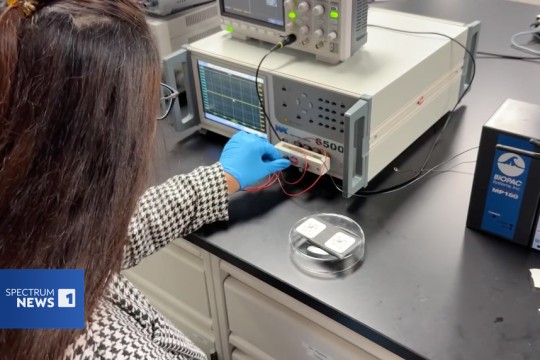RIT-RGHS Alliance awards seed funding to seven teams
A vaccine candidate that could prevent ear infections in children, an artificial bicep, noninvasive methods of monitoring women in labor — these are just a few of the collaborations inspired by the alliance between Rochester Institute of Technology and Rochester General Health System.
The RIT-RGHS Alliance has awarded a total of nearly $140,000 to seven research teams in its second round of funding. Recipients and their winning proposals are as follows:
Dr. Bishoy Faltas, Steven Day, Anthony Harkin, Edward Furlani, Siyang Zheng: “Using a modified IVC filter as an in-vivo magnetic bio-separation device to capture circulating tumor cells to prevent systemic cancer metastases using magnetic nano-particles.” This project seeks to modify an implantable magnetic device to selectively target circulating tumor cells in the circulation to prevent distant metastasis.
Kathleen Lamkin-Kennard, Elizabeth DeBartolo, Dr. Richard Barbano: “Design of a Pneumatically Actuated Robotic Assist Device for Patients with Foot Drop.” The study will develop a prototype for an active ankle-foot orthosis device that will pneumatically help individuals with ankle dorsiflexion, or the movement that brings the top of the foot towards the lower leg.
Lea Vacca Michel, Dr. Michael Pichichero, Leslie Kate Wright: “Searching for an alternative vaccine candidate for nontypable Haemophilus influenza.” This project focuses on identifying a P6-like protein as a vaccine candidate against nontypable Haemophilus influenza, a cause of otitis media or ear infections in children.
Dr. Patricia Newcomb and Sumita Mishra: “Novel methods of monitoring labor in electrohysterography.” This team will establish the methods and model, and gather patient data for analyzing the electrical activity of the uterus to achieve better insight into the process of labor and advance the emerging technology of electrohysterography.
Andreas Savakis, Gary Behm, Dr. Gwen Sterns: “Smartphone assistance for individuals with blind spots in their visual field.” This project will develop and evaluate a personal imaging system using smartphone technology (the Android system) to display important information within a user’s visual field.
Wayne Walter, William Spath, Dr. Michael Leit, Dr. Steven Posnick: “Feasibility of integrating multiple types of electroactive polymers to develop a biomimetic inspired muscle actuator.” The researchers will design, build and test an artificial bicep arm muscle prototype by integrating electroactive polymers to mimic how a human bicep muscle is composed of multiple types of muscle fibers. Integrating multiple EAP materials in a designed mechanical system could produce a closer representation of a biological muscle with fluid-like motion characteristics.
Anahita Williamson and Wayne Morton: “Develop and deliver training to Rochester General Hospital on the environmental and economic benefits of improved waste segregation.” The researchers will develop a program, including a training video and posters displayed in key areas throughout the hospital, to educate RGH employees about the environmental and economic impact of separating general and regulated medical waste. The estimated annual cost savings for the entire hospital could be as high as $200,000.
In round one, the alliance also awarded close to $140,000 to seven research teams.
Several recipients of alliance seed funding will showcase their projects during the RIT-RGHS Alliance Research Reception and Poster Session from 5:30–7:30 p.m. March 14 in the Rochester General Hospital atrium.
For more information about the RIT-RGHS Alliance, go to Rochester Regional Health and RIT Alliance.













